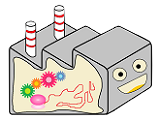C to A
- Project Detail
- Progress
- Materials and Methods
- The Experiments
- Result
- Data analysis
- Conclusion
Today paper is used in quantity every day and will be waste after use.
In Japan, for example, they send new year's card to relations, friends and acquaintances every year.
So some cards are thrown away when it is written incorrectly, stained or sent from disagreeable person.
It is a sheer waste to throw away many cards, so it is great idea that we transform card into MOCHI, tranditional Japanese food made from rice and composed of amylopectin.
Paper contains cellulose, and both amylopectin and cellulose are polyglucose.
Why we can't the transformation?
We genetically modify Escherichia coli and make 2 type of function. One of the function is synthesis of cellulase, which is enzyme analyzes cellulose into glucose. Another is synthesis of amylopectin synthetic enzyme. We use them to analyze cellulose (it compose new year’s card) and synthesize amylopectin (it is main ingredient of MOCHI). In 2008, the iGEM team of the University of Edinburgh studied reducing cellulose to glucose. We refer to this study and improve it to reduce cellulose. On the other hand we introduce gene coding amylopectin synthetic enzyme from Oryza sativa into E.coli to synthesize amylopectin in body of E.coli. In fact, E.coli have a function to synthesize glycogen from glucose in natural. So we use some parts of this function and remove some of them to realize the efficient transformation.
Theme of our project
-
Transform new year's card to rice cake
(make cellulose resolve and reconstruct it to synthesize amylopectin)
-
RNA shaped like a ring / ring-shaped RNA
(mass-produce protein by ring-shaped RNA)
Description
-
Today paper is used in quantity every day and will be waste after use.
In Japan, for example, they send new year's card to relations, friends and acquaintances every year.
So some cards are thrown away when it is written incorrectly, stained or sent from disagreeable person.
It is a sheer waste to throw away many cards, so it is great idea that we transform card into MOCHI, tranditional Japanese food made from rice and composed of amylopectin.
Paper contains cellulose, and both amylopectin and cellulose are polyglucose.
Why we can't the transformation?
We genetically modify Escherichia coli and make 2 type of function. One of the function is synthesis of cellulase, which is enzyme analyzes cellulose into glucose. Another is synthesis of amylopectin synthetic enzyme. We use them to analyze cellulose (it compose new year’s card) and synthesize amylopectin (it is main ingredient of MOCHI). In 2008, the iGEM team of the University of Edinburgh studied reducing cellulose to glucose. We refer to this study and improve it to reduce cellulose. On the other hand we introduce gene coding amylopectin synthetic enzyme from Oryza sativa into E.coli to synthesize amylopectin in body of E.coli. In fact, E.coli have a function to synthesize glycogen from glucose in natural. So we use some parts of this function and remove some of them to realize the efficient transformation.
-
In vivo, proteins are synthesized in transcription and translation.
Generally, mRNA is single-strand RNA, starting translation by binding ribosome on initiation codon, and ending by separating ribosome from mRNA.
In this study, we aim to build the method of synthesizing long-chain, massive proteins and to improve translation efficiency.
That is, allowing ribosomes to have a semi-permanent translation mechanism by producing circular mRNA and causing a defect of termination codon.
To cyclize mRNA, we can use a splicing mechanism of T4 phage.
Splicing is a mechanism removing circular introns which don't code for proteins and joining in exons which code for ones.
It occurs after transcription.
Splicing is catalyzed by several base sequences of the ends of introns as a ribozyme, being subjected to nucleophilic attack from introns to exons.
So we will introduce the plasmids which place the sequence of the end of introns as a splicing ribozyme on the end of a gene coding for proteins into E.coli, and cyclize mRNA for
synthesis of long-chain, massive proteins.



